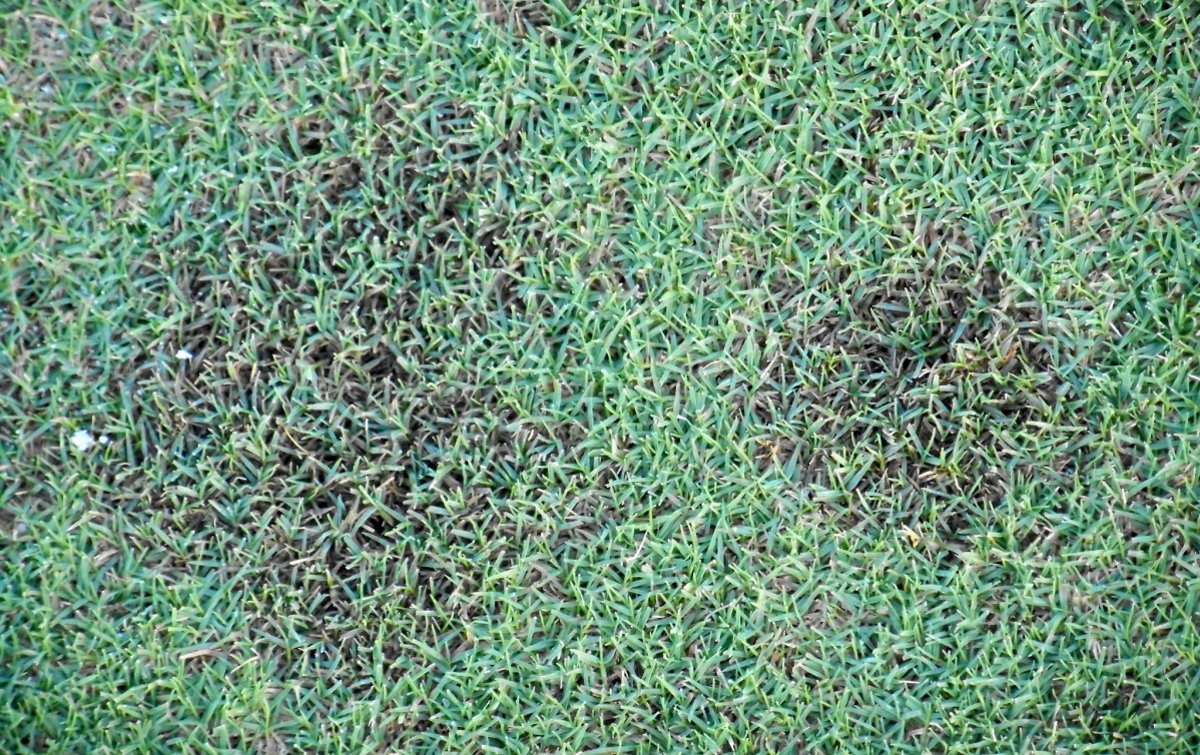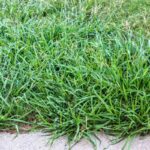
Dollar spot is a common fungal lawn disease that appears as patches of brown grass that start as small as a silver dollar. The good news is that this lawn disease is easy to treat as long as you take care of it in time. We’ll show you how to get rid of dollar spot with good lawn care and explain the role chemical control can play.
What is Dollar Spot?
Dollar spot is caused by a fungus called Clarireedia jacksonii (previously called Sclerotinia homoeocarpa). The pathogen thrives in environments with high humidity, especially when warm days are followed by cool nights and heavy dew.
This lawn fungus affects most cool-season grasses, such as Kentucky bluegrass, ryegrass, fescue, and bentgrass. While Bermudagrass and Zoysiagrass are the turfgrasses most susceptible, other warm-season species can be infected.
How to Identify Dollar Spot

When you’re trying to spot the dollar spot in your lawn, look for the following signs:
- Circular patches: These are small, round patches of light brown or straw-colored grass, usually measuring around 1 to 4 inches in diameter.
- Expanding areas: The patches may merge to form large affected areas.
- Spiderweb-like growths: In the morning dew, you may see cobweb-like growths or strands on the grass blades called mycelium. Mycelium is a network of delicate, thread-like structures called hyphae that help the fungi spread and obtain nutrients in the affected area.
- Reddish-brown edges: Close examination of the grass leaf blades may reveal small, tan-colored lesions or spots with red-brown borders.
Pro tip: Dollar spot and brown patch are similar fungal lawn diseases. You can consult a lawn care professional or take a sample to a local Extension office to help identify the fungus in your yard.
How to Get Rid of Dollar Spot
Dollar spot can be treated in a variety of ways, through both cultural lawn care practices and chemical fungicide treatments.
Cultural Practices
Try these lawn care practices to stop dollar spot in its tracks — and keep it from coming back.
- Mow properly: Maintain the appropriate mowing height for your grass type. Avoid cutting the grass too short, as this can weaken the plants and make them more susceptible to disease. Regularly sharpen your mower blades to ensure clean cuts and minimize stress on the grass.
- Reduce thatch: Excess thatch provides an ideal environment for dollar spot fungi to thrive. Why? Clarireeda jacksonii feeds on excess thatch in your yard. Regularly dethatch your lawn to remove excess organic debris and promote better air circulation.
- Improve soil drainage: To prevent excessive moisture buildup, enhance soil drainage through aeration. Aeration creates holes in the soil, improving air circulation, water drainage, and nutrient absorption. It also reduces thatch buildup and compacted soil, promoting healthy grass roots.
- Apply mulch: Mulching can help maintain the health of your lawn. When your lawn is healthy, using grass clippings as mulch is an eco-friendly and cost-effective option, especially since you already have them available after mowing your lawn.
Pro tip: When your grass is infected with dollar spot, bag the clippings while mowing to prevent spreading it around your yard.
- Promote strong grass: Fertilize your lawn with organic or synthetic fertilizer to help it recover from dollar spot quickly. Conduct a soil test to determine what nutrients your lawn needs.
- Minimize shade: Dollar spot tends to be more prevalent in shaded areas. Prune shrubs or trees that cast excessive shade on your lawn to allow for better sunlight exposure and air circulation.
- Adjust your watering schedule: Proper irrigation timing reduces the risk of drought stress and dollar spot lawn disease. Water deeply and infrequently, taking into account the moisture level of your soil rather than following a set calendar schedule.
Pro tip: Aim to water in the early morning hours (before 8 a.m.) to avoid prolonged wetness during cool nights, or consider the cost of installing a sprinkler system.
Chemical Methods
Chemical methods are another option to control dollar spot. Fungicides can be applied to treat dollar spot, but they are more effective at preventing this lawn disease. Many of the best fungicides include one of the following active ingredients.
- Boscalid
- Myclobutanil
- Propiconazole
- Triadimefon
- Triticonazole
- Vinclozolin
Pro Tip: Dollar spot becomes resistant to fungicides quickly, so it is recommended to regularly change the fungicide used to lower the risk of resistance.
When treating an ongoing infection, fungicides should be applied at high rates and short application intervals with even coverage throughout the lawn.
Here are the steps to get rid of dollar spot using chemical methods:
- Follow instructions: Read the label and carefully follow the directions on your product.
- Dry application: Apply granular fungicides evenly to a dry lawn with a fertilizer spreader, and thoroughly water down the treated areas afterward.
- Wet application: Mix the fungicide as instructed on the label, and invest in a weed sprayer to distribute it evenly over the affected areas of the grass. Ensure you set the sprayer nozzle for thorough coverage.
- Calculate the quantity: Different fungicides require different application rates. Consult the product label for precise information. Follow the instructions closely to ensure the correct dosage of application.
- Spreader setting: Your spreader’s dial should be adjusted according to the instructions on the back of the package.
- Avoid drift: It’s best to spray liquid fungicides on a calm day, as wind can carry the product to other areas and reduce effectiveness.
- Perimeter first: To start, apply the fungicide along the perimeter of the lawn. Fill in the interior of the lawn using rows, like you’re adding stripes to your lawn.
How to Repair a Lawn Damaged by Dollar Spot

With a little hands-on care, your yard can bounce back from a dollar spot infection, especially if it was healthy beforehand and you treat the disease quickly.
You can keep your lawn green and healthy by preventing dollar spot through proper lawn care practices. To repair a lawn damaged by dollar spot, follow these steps:
- Remove dead grass: Use a thatch rake or a dethatching machine to eliminate the dead grass and any thatch buildup.
- Replant or overseed: Once the affected areas are cleared, replant or overseed the damaged spots with healthy grass seeds. Choose a grass variety resistant to dollar spot to prevent future outbreaks. You also have the option to lay sod to replace the damaged areas.
- Water and fertilize: To ensure proper growth, regularly water the newly planted grass seeds. Keep the soil moist, but avoid waterlogging. Also, apply a balanced fertilizer to give the grass the nutrients it needs to grow and recover.
How to Prevent Dollar Spot
There are plenty of ways to prevent dollar spot from taking hold in your yard. Some routine lawn care practices — and several ounces of prevention in the form of a fungicide — can cut the risk of dollar spot infection.
- Use fungicides: Fungicides can prevent dollar spot ahead of its prime season in late spring and early summer. Simply apply lawn treatments every 14-28 days to keep your lawn free of fungus and look healthy and green all summer.
Remember, mix up which fungicide you use to keep resistance from developing. - Proper lawn care: Maintain good cultural practices, such as regular lawn mowing, watering, aerating, and dethatching. Avoid overwatering and excessive thatch buildup, as these conditions can promote the growth of dollar spot fungus. Dry soil also promotes the disease.
- Use fertilizer: Fertilize your lawn to reduce the risk of poor nutrient levels. Dollar spot spreads quickly in nutrient-poor soils, especially soils with low nitrogen. Ensuring your lawn is nourished will help control the risk.
- Improve air circulation: Encourage good air circulation by pruning trees and shrubs that may be shading your lawn. This will help reduce moisture buildup and decrease the likelihood of lawn fungus development.
- Monitor and treat early: Regularly inspect your lawn for signs of dollar spot. Immediately treat the affected areas with appropriate fungicides or cultural practices if you notice any symptoms.
- Whip and drag method: Golf course landscaping professionals use the whip and drag method to prevent dollar spot on turf. This technique involves gently brushing or dragging a flexible tool across the lawn. To minimize dew buildup, whip and drag the grass early in the morning. However, refrain from doing this during an active infestation, as it can spread the fungal disease.
FAQ About Getting Rid of Dollar Spot
Will Dollar Spot Go Away on Its Own?
Sometimes, dollar spot may go away on its own if the conditions that promote its growth are no longer present. However, it is recommended to take proactive measures to prevent and treat dollar spot to ensure the health and appearance of your lawn.
Using proper lawn care practices, such as improving air circulation, reducing thatch buildup, and monitoring and treating early, can help control and prevent dollar spot. Additionally, using fungicides as a preventive measure can effectively manage the disease.
Why Does My Lawn Keep Getting Dollar Spot?
Dollar spot can reoccur in lawns for several reasons. These include favorable conditions for the fungus to thrive, such as warm and humid weather, overwatering, excessive thatch buildup, and low mowing heights.
Weakened or stressed grass, nutrient deficiencies, improper lawn care practices, and environmental factors can also increase susceptibility to dollar spot.
What is the Best Dollar Spot Fungicide?
The best fungicides for controlling dollar spot include those containing the following active ingredients:
- Boscalid
- Myclobutanil
- Propiconazole
- Triadimefon
- Triticonazole
- Vinclozolin
These fungicides are effective in treating and preventing dollar spot. It is important to read and follow the instructions on the product label for proper application and dosage.
When to Call a Lawn Care Pro for Help
Dollar spot is a common fungal disease, and our lawn care experts can eliminate it for you. In fact, LawnStarter pros can keep your grass green and healthy no matter what lawn challenges the year may bring. But remember: Act early, and it won’t cost you a lot of dollars to get rid of dollar spot.
Main Image Credit: Scot Nelson / Flickr / Public domain



![7 Best Fertilizers for Grass in 2022 [Reviews]](https://www.lawnstarter.com/blog/wp-content/uploads/2023/12/Best-Fertilizers-for-Grass-150x150.jpg)

